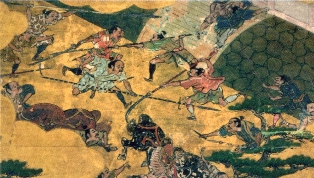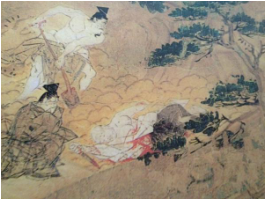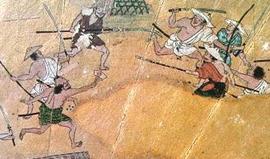 Miyoshi Yukinaga. Source: Wikipedia
Miyoshi Yukinaga. Source: Wikipedia Chapter One The advance from Shikoku (continued from last week)
Miyoshi Yukinaga and the Hosokawa clan
1 The Hosokawa, shugo of Awa province, and the Muromachi Bakufu
According to the various military tales and genealogies composed about the Miyoshi clan during the Edo period, the Ogasawara of Shinano province were appointed as the shugo (an official position similar to a governor) over Awa province during the Kamakura period. A descendant of that family established himself in Miyoshi-gun (district) at the mouth of the Yoshino river, and there took the surname Miyoshi.
While it is certainly true that this person belonged to the same family, as is often the case with many of the figures of the Era of the Warring States, it is difficult to verify the validity of claims about origins.
A primary source detailing the origins of the Miyoshi first appeared in the latter half of the fifteenth century. On the 24th of the second month of Kanshō 6 (1465), Inō Shinkaku, the bugyōnin (overseer) appointed by the shugo of Awa province Hosokawa Shigeyuki, ordered one “Miyoshi Shikibu no Shō” to accumulate information about taxation paid across 3-gun districts. In Awa province at the time, the shugodai (a deputy to the shugo) of the Tōjō clan amalgamated a number of provincial districts and appointed either ko-shugodai (an assistant, usually a retainer, to the shugodai) or gundai (district administrators) to each. In the southern gun, Tōjō Wakasa Nyūdō, and in the north and west Miyoshi Shikibu no Shō, were two of these individuals.
In the first year of Bunmei (1469), Inō Shinkaku issued a directive to Miyoshi Shikibu no Shō, Kataho Hitachi Nyūdō, and Henmi Bungo Nyūdō to collect tithes from their respective districts. Kataho was from Izu province and a descendant of a hikan (a retainer granted land and special authority in exchange for military service) of the Hōjō Tokusō clan of the Kamakura Bakufu. The Henmi clan was from Kai province, and like the Takeda and Ogasawara clans, lay claim to Minamoto no Yoshimitsu as an ancestor. Both families (Kataho and Henmi) thus bore illustrious lineages, yet if the Miyoshi were also descended from the Ogasawara, wouldn’t it have made more sense for them to also take a surname from a geographical feature in the eastern provinces?
Following the chain of logic here, the Miyoshi were most likely kokujin (a prominent local samurai family) in Awa province, who grew in influence to become the gundai of the north western region of Awa. In their search for a more illustrious lineage, many kokujin status families in Awa like the Ichinomiya began to describe themselves as descended from the Ogasawara clan, thus leading to the establishment of the Ogasawara theory of origin.
There is also a theory that this Miyoshi Shikibu no Shō was a direct ancestor of Miyoshi Yukinaga, Motonaga and Nagayoshi, each of whom would make their mark in the Kinai region (Yamashiro, Yamato, Settsu, Kawachi, and Izumi provinces). However all three chose to give themselves the title of ‘Chikuzen no Kami’ (a common practice among prominent military figures of this era was to appoint themselves to positions based on former Imperial titles, in this case ‘kami’. The title held no actual rank, and was more a trend adopted to make one appear more illustrious. Chikuzen is the former name of modern Fukuoka prefecture). While it is possible that the family’s lineage was altered at some point, we do know that in Tenshō 9 (1581) there was still a family by the name of Miyoshi in Awa province using the official title ‘Shikibu no Shō’. Hence the chances that Yukinaga, Motonaga and Nagayoshi had a common ancestor in Shikibu no Shō are rather slim.
It does appear that in the aftermath of the Ōnin War, in the seventeenth year of Bunmei (1485), Hosokawa Nariyuki and his son Masayuki were accompanied by members of the Miyoshi clan in their journey from Kyoto to Awa. So rather than originally being from Awa, there was a Miyoshi family active in Kyoto at the time. It seems more likely that the family of Miyoshi Shikibu no Shō that came to administer the north-western regions of Awa were originally the main branch of the family, while the Miyoshi that later came to adopt the more prestigious title of ‘Chikuzen no Kami’ were retainers in the service of the shugo of Awa province residing in Kyoto. Yukinaga, Motonaga and Nagayoshi were the descendants of these retainers, and during the course of the Era of the Warring States, it was this family that would eventually come to be regarded as the main branch of the Miyoshi clan.
The Muromachi Bakufu and the Hosokawa clan
The Muromachi Bakufu maintained a policy of dividing up its authority into regions, namely the Kantō, Tōhoku and Kyūshū. To the position of Kamakura Kubō (a position overseeing the administration of 10 provinces in the Kantō region) it appointed the fourth son of Ashikaga Takauji, Ashikaga Motouji, while in relation to the position of Kantō Kanrei (a position providing advice to the Kamakura Kubō and appointed by the shōgun) they appointed the Uesugi clan, a family from whom Takauji’s mother was descended. To the position of Ōshū Tandai (overseeing the far northern provinces) they appointed the Ōsaki clan (a branch of the aristocratic Shiba family), while the Mogami clan (another branch of the Shiba family) were appointed as the Ushū Tandai (the area of north western Honshū now occupied by Akita and Niigata prefectures).
The position of Kyūshū Tandai went to the Shibukawa clan, thereby ensuring that all of these prestigious posts were occupied by illustrious families tied through blood relations to the Ashikaga Bakufu. On the other hand, the Tokai, Hokuriku, Kinnai, Chūgoku and Shikoku regions (known collectively as the Muromachi Dono Gobunkoku) were under the direct control of the shōgun, while the shugo of the same stretch of territory were expected to reside in Kyoto. Those who became shugo included the Akamatsu and Sasaki clans, both of whom had been instrumental in the formation of the Ashikaga Bakufu, and apart from prestigious families dating from the Kamakura era including the Ōuchi, Ōtomo, and Kōno, all fell under the Ashikaga banner. The basic administration adopted by the Bakufu involved shugo combining their responsibilities for numerous provinces throughout the country with control over those same areas, all the while providing the shōgun and the Bakufu government in Kyoto with support.
One issue that emerged for the Ashikaga shōgun during the Nanbokuchō period (roughly 1336 to 1392) was how to secure their position while simultaneously fighting both the Southern Court and restraining more influential members of their own family. Their solution was to make the Northern Court appreciate the significance of the role of the shugo, remove the influence of any other branches of the Ashikaga family so that the shōgun monopolized contact with the Emperor, and ensure that only the shōgun’s family occupied high office.
Meanwhile the Hosokawa clan, itself a branch of the Ashikaga family, had pacified Shikoku during Ashikaga Takauji’s retreat to Kyūshū, Through their assistance rendered to Ashikaga Yoshimitsu, Yoshimitsu was able to consolidate the authority of the shōgun. The Hosokawa were, in turn, appointed as senior councilors within the Ashikaga Bakufu. Generations of the Hosokawa clan would take the position title of Ukyō no Daibu (many of the official positions within the Bakufu and imperial system took names derived from Chinese bureaucratic titles), which in time became known as the Ukei chō. The main branch of the Hosokawa family, under the title of Ukei chō, would become one of the three principal families appointed to the position of kanrei (the Sanrankei) together with the Shiba and Hatakeyama. They would then combine their Bakufu duties to simultaneously serve as shugo to the provinces of Settsu, Tanba, Sanuki and Tosa.
The Hosokawa also had their own influential sub-branches of the family. Among those who only served in the position of shugo included the Awa, Awaji, Bichū, Izumi-kami and Izumi-shimo families. Non-shugo branch families such as the Yashū and Tenkyū would serve as retainers to the Ukei chō.
At the height of the Muromachi Bakufu, the shōgun held a conference examining important proposals, receiving opinions from a variety of councilors. Those councilors included the sankanrei (see earlier), the Yamana, Isshiki, Akamatsu, and the Awa. In the beginning, these families would wait upon the shōgun, taking up guest spots and holding special status which allowed their attendance at events. With the coming of the Era of the Warring States, these families would be consolidated into the Go shōban shū, a group the membership of which served as proof that one belonged to a powerful, influential clan. The Awa became as renowned as the sankanrei, Yamana, Isshiki, Akamatsu, Kyōgoku, Hatakeyama, and Ōuchi. In other words, the Awa on their own became a mainstay of the Bakufu, one rank below the Ukei chō.
The Hosokawa were proud of their strong familial ties. By the mid-fifteenth century, unlike the Hatakeyama that had split into the Masanaga and Yoshihiro factions and fought among themselves, the Hosokawa had emerged as the leaders of the Bakufu government.








 RSS Feed
RSS Feed